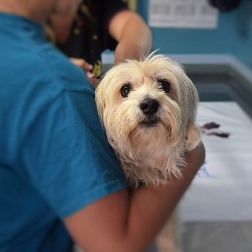How to Pick a Veterinary Technician School near Wood South Dakota
 Achieving your long term goal of working with and caring for pets by enrolling in a vet tech school near Wood SD might at first feel like a daunting task. After all, you have to search for and enroll in a college that will deliver the proper training to ensure that you can be successful as a veterinary technician. But just how do you tackle evaluating and contrasting programs so that you can make the correct selection? Many aspiring students begin their due diligence process by looking for campuses that are close to their residences. After they have located some local colleges, they ascertain which ones have the lowest tuition and hone in on those. Although expense and location are important factors when assessing vet tech schools, they are not the only critical ones when making your evaluations. Qualifications such as accreditation and internship programs should be looked into also. The point is that there are questions you should be asking the veterinary technician schools you are evaluating before you make a final selection. We have presented several in this article in order to help get you started, but before we discuss them we’ll talk about the various roles of veterinary technicians and the training options offered.
Achieving your long term goal of working with and caring for pets by enrolling in a vet tech school near Wood SD might at first feel like a daunting task. After all, you have to search for and enroll in a college that will deliver the proper training to ensure that you can be successful as a veterinary technician. But just how do you tackle evaluating and contrasting programs so that you can make the correct selection? Many aspiring students begin their due diligence process by looking for campuses that are close to their residences. After they have located some local colleges, they ascertain which ones have the lowest tuition and hone in on those. Although expense and location are important factors when assessing vet tech schools, they are not the only critical ones when making your evaluations. Qualifications such as accreditation and internship programs should be looked into also. The point is that there are questions you should be asking the veterinary technician schools you are evaluating before you make a final selection. We have presented several in this article in order to help get you started, but before we discuss them we’ll talk about the various roles of veterinary technicians and the training options offered.
The Role of a Vet Tech in Wood SD
 One of the initial decisions that you will have to make is whether you desire to train as a veterinary assistant, technologist or technician. Part of your decision may be predicated on the amount of time and money that you have to commit to your training, but the main factor will undoubtedly be which specialization appeals to you the most. What techs and assistants have in common is that they each work under the immediate supervision of a practicing and licensed veterinarian. And while there are many tasks that they can perform within the Wood SD veterinary practice or hospital, they can’t prescribe medicines, diagnose ailments, or perform surgical procedures. In those areas they can only provide assistance to a licensed veterinarian. There are technologists and technicians that work exclusive of the standard vet practice, such as for zoos, animal shelters or police departments. Let’s take a look at the responsibilities and training prerequisites for each position.
One of the initial decisions that you will have to make is whether you desire to train as a veterinary assistant, technologist or technician. Part of your decision may be predicated on the amount of time and money that you have to commit to your training, but the main factor will undoubtedly be which specialization appeals to you the most. What techs and assistants have in common is that they each work under the immediate supervision of a practicing and licensed veterinarian. And while there are many tasks that they can perform within the Wood SD veterinary practice or hospital, they can’t prescribe medicines, diagnose ailments, or perform surgical procedures. In those areas they can only provide assistance to a licensed veterinarian. There are technologists and technicians that work exclusive of the standard vet practice, such as for zoos, animal shelters or police departments. Let’s take a look at the responsibilities and training prerequisites for each position.
- Vet Assistants in almost all instances will have undergone a structured training program, either as an apprentice or intern in a practice, or by finishing a certificate program at a trade school or community college. As the name implies, their job function is to assist the veterinarians and vet techs in the completion of their duties. Normally they are not associated with more involved tasks, for example assisting with surgical procedures. Some of their typical functions may include working at the front desk, cleaning and preparing exam rooms and equipment, or controlling animals during exams.
- Vet Technicians undergo more extensive training compared with assistants and usually obtain a 2 year Associate Degree, ideally from an American Veterinary Medical Association (AVMA) accredited program. They are in a sense the veterinarian counterparts of medical nurses, since their basic job duty is to assist veterinarians with diagnosing and treating animal patients. Where they vary from veterinary assistants is that they are included in more involved tasks, for example assisting with surgical procedures or providing medication. All states presently require veterinary techs pass a credentialing examination for either registration, certification or licensing.
- Vet Technologists are comparable to veterinary techs and for the most part carry out the same job functions. They are required to earn a Bachelor’s Degree in veterinary technology, which generally takes 4 years to complete. So the only real difference between a vet technician and a technologist is the technologist’s more advanced level of education. But with an advanced degree comes more job opportunities, increased salaries and potential management positions. They are also required to pass a credentialing examination for either certification, registration or licensing.
Veterinary techs and technologists may specialize in areas such as anesthesia, internal medicine or emergency care. Some may acquire certification from the American Association for Laboratory Animal Science (AALAS) to work in Wood SD labs or research facilities also.
Online Veterinary Technician Schools Offered in Wood
 An option that may make sense for those with a busy schedule or who are working full time while going to veterinary school is to enroll in an online program. Because the classes are provided through the internet, students can study on their own timetable wherever a computer is accessible. The curriculum is taught using multiple venues, including slide shows, videos and live streaming webinars. And since many vet technician and technologist degrees require practical training, that portion can usually be fulfilled as an internship or work study program at a local Wood SD veterinary clinic or hospital. Distance learning, as it is also called, can in many instances lower the cost of your education. Tuition and supplementary expenses, such as for commuting and study supplies, can be more affordable compared to more standard classroom courses. Just confirm that the program that you enroll in is accredited, either by the AVMA or another nationally recognized accrediting agency. With the online courses and the clinical training, everything is provided for a complete education. So if you are dedicated enough to learn in this more independent mode, an online vet tech program may be the right option for you.
An option that may make sense for those with a busy schedule or who are working full time while going to veterinary school is to enroll in an online program. Because the classes are provided through the internet, students can study on their own timetable wherever a computer is accessible. The curriculum is taught using multiple venues, including slide shows, videos and live streaming webinars. And since many vet technician and technologist degrees require practical training, that portion can usually be fulfilled as an internship or work study program at a local Wood SD veterinary clinic or hospital. Distance learning, as it is also called, can in many instances lower the cost of your education. Tuition and supplementary expenses, such as for commuting and study supplies, can be more affordable compared to more standard classroom courses. Just confirm that the program that you enroll in is accredited, either by the AVMA or another nationally recognized accrediting agency. With the online courses and the clinical training, everything is provided for a complete education. So if you are dedicated enough to learn in this more independent mode, an online vet tech program may be the right option for you.
Things to Ask Wood SD Veterinary Technician Programs
 At this point you probably have decided on which veterinarian credential that you would like to earn, and if you intend to study online or attend a school on campus. Since there are a large number of vet community colleges, vocational and trade schools in the Wood SD area as well as across the Country, you must ask some relevant questions to help fine tune your list of options. As we mentioned in our opening, many future students start by focusing on location and tuition expense. But we have already touched on other important qualifiers, for instance internship programs and accreditation. And obviously you need to choose a school that offers the specialty and degree that you are interested in. These and other qualifications are addressed in the checklist of questions that you should ask the veterinary technician colleges that you are looking at.
At this point you probably have decided on which veterinarian credential that you would like to earn, and if you intend to study online or attend a school on campus. Since there are a large number of vet community colleges, vocational and trade schools in the Wood SD area as well as across the Country, you must ask some relevant questions to help fine tune your list of options. As we mentioned in our opening, many future students start by focusing on location and tuition expense. But we have already touched on other important qualifiers, for instance internship programs and accreditation. And obviously you need to choose a school that offers the specialty and degree that you are interested in. These and other qualifications are addressed in the checklist of questions that you should ask the veterinary technician colleges that you are looking at.
Is the Veterinary College Accredited? It’s imperative that you confirm that the vet tech school you choose is accredited by a regional or national accrediting agency. As previously discussed, one of the most highly regarded is the American Veterinary Medical Association (AVMA). Vocational schools and colleges that are accredited by the AVMA have gone through a thorough review process that confirms you will receive a quality education. Also, accreditation is necessary if you are applying for a student loan or financial aid, since a large number of programs are not available for non-accredited colleges. Last, having a degree or certificate from an accredited program is frequently a prerequisite for employment for many Wood SD area vet clinics and hospitals.
What is the School’s Reputation? The veterinary college or vocational school and program you select should have an excellent reputation within the vet community. You can start your due diligence by asking the colleges you are reviewing for endorsements from the employers in their job placement network. Other pointers include looking on internet school rating websites and speaking with the school’s accrediting agencies as well. You can ask the South Dakota school licensing department if there have been any complaints or violations involving your specific schools. As a final recommendation, contact some Wood SD veterinary clinics that you may wish to work for after you get your training. Ask what they think of your school choices. They may even suggest some programs not on your list.
Are Internships Offered? The most effective approach to obtain clinical hands on experience as a vet tech is to work in a clinical setting. Find out if the schools you are looking at have internship programs established with Wood SD veterinarians, vet practices or hospitals. The majority of veterinary medicine programs require practical training and a large number provide it through internships. Not only will the experience be invaluable regarding the practical training, but an internship may also help establish associations in the local veterinarian community and aid in the search for a position after graduation.
Is Job Assistance Provided? Searching for a job after graduating from a veterinary technician program can be challenging without the help of a job placement program. First, find out what the graduation rates are for the colleges you are reviewing. A lower rate could indicate that the teachers were unqualified to teach the course of study or that a number of students were disappointed with the program and quit. Next, verify that the schools have a job assistance program and find out what their placement rates are. A high placement rate might indicate that the program has an exceptional reputation within the Wood SD vet community and has a considerable network of contacts for student placements. A lower rate might indicate that the training is not highly regarded by employers or that the job assistance program is ineffective at placing students.
How Large are the Classes? If the classes are larger in size, you may receive little or no personalized instruction from the teachers. Request from the Wood SD colleges you are looking at what their class teacher to student ratios are. You may also decide to attend a few classes (if practical) to monitor the interaction between teachers and students. Ask for evaluations from students relating to the quality of instruction. Also, speak with the instructors and determine what their backgrounds are as well as their approaches to teaching.
Where is the School Located? Okay, we previously talked about location, but there are a couple of more points to make on the topic. If you are going to drive to your vet tech classes from your Wood SD home, you have to make sure that the commuting time fits into your schedule. For example, driving during the weekend to check out the route won’t be the same as the drive during rush hour traffic, especially if the campus is located near or in a larger city. Also, if you do opt to attend a college in another state or even outside of your County of residence, there may be higher tuition charges particularly for state and community colleges. On the other hand, attending online classes might be an alternative that will provide you with more flexibility and minimize the need for travel.
Is the Class Schedule Flexible? And last, it’s imperative that you ascertain if the veterinary colleges you are looking at offer class times flexible enough to accommodate your schedule. For instance, a number of students continue to work full time and can only go to classes on the weekends or in the evenings near Wood SD. Some might only be able to go to classes in the morning or later in the afternoon. Confirm that the class times you need are available before enrolling. In addition, determine if you can make-up classes that you may miss as a result of illness, work or family emergencies. You might find that an online college is the best way to fit your vet training into your active life.
Enrolling in a Vet Tech School near Wood SD?
If you have decided to attend a Veterinary Technician Program in the Wood South Dakota area, then you may find the following information about the location of your school campus interesting and informing.
Whitewood, South Dakota
As of the census[3] of 2010, there were 927 people, 374 households, and 232 families residing in the city. The population density was 1,448.4 inhabitants per square mile (559.2/km2). There were 392 housing units at an average density of 612.5 per square mile (236.5/km2). The racial makeup of the city was 91.9% White, 0.8% African American, 3.7% Native American, 0.1% Asian, 0.3% from other races, and 3.2% from two or more races. Hispanic or Latino of any race were 2.5% of the population.
There were 374 households of which 33.4% had children under the age of 18 living with them, 46.8% were married couples living together, 8.3% had a female householder with no husband present, 7.0% had a male householder with no wife present, and 38.0% were non-families. 30.7% of all households were made up of individuals and 12.3% had someone living alone who was 65 years of age or older. The average household size was 2.44 and the average family size was 3.05.
The median age in the city was 38.8 years. 26.9% of residents were under the age of 18; 6.5% were between the ages of 18 and 24; 23.7% were from 25 to 44; 28.8% were from 45 to 64; and 14.1% were 65 years of age or older. The gender makeup of the city was 50.6% male and 49.4% female.
Enroll in the Right Veterinary Technician School near Wood SD
 Choosing the ideal veterinary technician college is an important first step to beginning a rewarding career providing treatment and care for pets and livestock. Potential students considering vet tech colleges must make their determination based on several key issues. Veterinary technicians and technologists are employed in vet clinics, animal hospitals and animal shelters. They typically take on administrative duties and assist the veterinarian with the animal patients when needed. As we have covered, it’s imperative that you select a veterinary medicine program that is both accredited and has an excellent reputation within the field. This applies to online vet tech colleges as well. By asking the questions included in our checklist for reviewing schools, you will be able to narrow down your alternatives so that you can make your final choice. And by choosing the ideal school, you can reach your goal of becoming a vet tech in Wood SD.
Choosing the ideal veterinary technician college is an important first step to beginning a rewarding career providing treatment and care for pets and livestock. Potential students considering vet tech colleges must make their determination based on several key issues. Veterinary technicians and technologists are employed in vet clinics, animal hospitals and animal shelters. They typically take on administrative duties and assist the veterinarian with the animal patients when needed. As we have covered, it’s imperative that you select a veterinary medicine program that is both accredited and has an excellent reputation within the field. This applies to online vet tech colleges as well. By asking the questions included in our checklist for reviewing schools, you will be able to narrow down your alternatives so that you can make your final choice. And by choosing the ideal school, you can reach your goal of becoming a vet tech in Wood SD.
Other Doggone Good Cities in South Dakota
